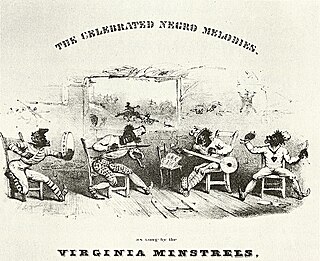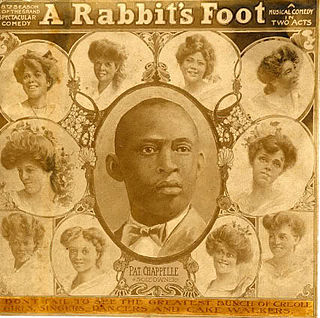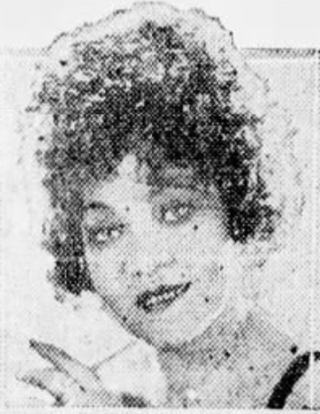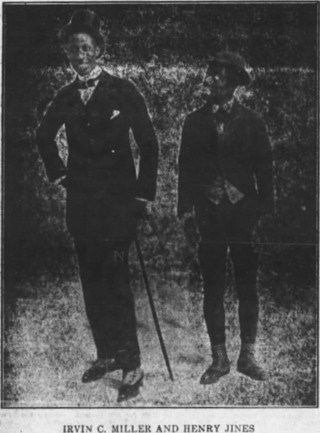Related Research Articles

The minstrel show, also called minstrelsy, was an American form of theater developed in the early 19th century. The shows were performed by mostly white actors wearing blackface makeup for the purpose of comically portraying racial stereotypes of African Americans. There were also some African-American performers and black-only minstrel groups that formed and toured. Minstrel shows stereotyped blacks as dimwitted, lazy, buffoonish, cowardly, superstitious, and happy-go-lucky. Each show consisted of comic skits, variety acts, dancing, and music performances that depicted people specifically of African descent.

The Rabbit's Foot Company, also known as the Rabbit('s) Foot Minstrels and colloquially as "The Foots", was a long-running minstrel and variety troupe that toured as a tent show in the American South between 1900 and the late 1950s. It was established by Pat Chappelle, an African-American entrepreneur in Tampa, Florida.

Flournoy Eakin Miller, sometimes credited as F. E. Miller, was an American entertainer, actor, lyricist, producer and playwright. Between about 1905 and 1932 he formed a popular comic duo, Miller and Lyles, with Aubrey Lyles. Described as "an innovator who advanced black comedy and entertainment significantly," and as "one of the seminal figures in the development of African American musical theater on Broadway", he wrote many successful vaudeville and Broadway shows, including the influential Shuffle Along (1921), as well as working on several all-black movies between the 1930s and 1950s.
William King was an African-American vaudeville comedian who led the ‘’’Billy King Stock Company’’’ who was described as "a living link between the Harlem Renaissance and nineteenth-century black minstrelsy." He married fellow performer Hattie McIntosh.
Juanita Stinnette Chappelle was a singer and vaudeville performer, as well as co-founder of Chappelle and Stinnette Records during the Harlem Renaissance era. Their record label was founded around 1921 and is considered one of the earliest labels owned and operated by African Americans. They produced 6 records, five of which they performed on.

Gonzell White, also written Gonzelle White, was an American jazz, blues, and vaudeville performer in the United States.
Hattie McIntosh was a vaudeville performer who toured with successful shows and her husband, fellow performer Tom McIntosh (comedian).
Sybil Lewis was an actress in the United States. An African American, she appeared in several films including musicals during the 1940s. She appeared in African American films and Hollywood pictures. She had starring roles in several African American films including Lucky Gamblers and Am I Guilty? and portrayed smaller roles including as a maid in Hollywood films. She also had a leading role in Broken Strings (film) in 1940.

Emmett Anthony was an American vaudeville comedian who appeared on stage in various revues and shows. In December 1915 he arrived in New Orleans on the S.S. Brunswick to perform at the Iroquis Theater. He was also in the film Son of Satan and was part of Blackville Corporation's 1915 touring revival, The Mayor of Jimtown touring show in 1923, and Harlem Darlings revue in 1929. He featured as a regular at the Crescent Theatre in 1913. He was in Liza in 1923. He received a favorable assessment for his part in Put and Take.
Maceo Bruce Sheffield was a police detective and an actor in American films. He worked in Los Angeles as a policeman before acting and assisting in the production of films with African American casts. He was also a stuntman and pilot. He portrayed a swindler in Lucky Ghost as Dr. Brutus Blake in the sequel to Mr. Washington Goes to Town. He was the associate producer of both Lucky Ghost and Mr. Washington Goes to Town.
Marion A. Brooks was an actor, playwright, and theater businessman. He partnered on the Bijou theater company at the newly established Bijou Theater in Montgomery, Alabama with players from Chicago. After it folded, he returned to work at the Pekin Theatre in Chicago.
Charlotte Grady Roxborough was a singer, dancer, and comedian who performed in theatrical productions and vaudeville as well as films. She was born to Wesley, a white father, and Susan (Kelly) Grady. She performed at the Pekin Theatre in Chicago where she was a star member of its stock company. She starred in William Foster's The Pullman Porter, in 1912, the first black motion picture production.
Jerry Mills was a performer at the Pekin Theatre in Chicago. and in films.

Henry Jines was an American vaudeville actor. He starred in stage productions including Irvin Miller's Broadway Rastus, and performed in blackface.
The McCarver Brothers, Howard McCarver and William McCarver, performed in minstrel and vaudeville shows from the late 19th century into the 20th. William McCarver was lauded for his make-up, contortion, singing, and dancing in his comedy duo performances.
Harrison Stewart was a comedic actor and lyricist in the United States. He performed at the Pekin Theater in Chicago where he became a star and received top billing.
Joe Byrd was an American vaudeville comedian. He was from Jacksonville, Florida.
George Washington Bullion was a popular and long running three act musical comedy by the Tutt Brothers, Salem Tutt Whitney and J. Homer Tutt that debuted in 1910. Trevor L. Corwell, a white English impresario helped book the show. The storyline featured a black tobacco plantation owner aspiring to join high society. The Tutt brothers’ shows George Washington Bullion Abroad and How Newtown Prepared followed up on the characters in 1915 and 1916. Both shows had the characters of Washington and fellow veterans leaving to fight in foreign wars.
Harry Kraton, sometimes given as Harry Craton and Harry Krayton, was an African American juggler and tightrope walker who performed in minstrel shows and in vaudeville from 1899 until his death in 1912 at the age of 29. As a juggler he specialized in a genre of juggling known as hoop rolling. With his wife Ethelyn Kraton, he co-founded the hoop rolling vaudeville act The Kratons in 1906 and spent the remainder of his life touring in vaudeville in the United States and to Europe where he performed in music halls. Kraton was an early advocate for black performers on the American stage. He wrote an op-ed in Variety magazine arguing for the acceptance of black performers in vaudeville. In 1909 he was a charter member of the Colored Vaudeville Benevolent Association.
Plantation Days (1922) was a touring musical revue with Sam Wooding and James P. Johnson as musical directors at different stages of the tour. Produced by Morris "Maury" Greenwald, the touring show was conceived to capitalize on Plantation Revue (1922-23), the successful show staged by Lew Leslie.
References
- ↑ Sampson, Henry T. (October 30, 2013). Blacks in Blackface: A Sourcebook on Early Black Musical Shows. Scarecrow Press. ISBN 9780810883512 – via Google Books.
- 1 2 3 4 "Blondie Robinson collection of African-American Minstrel and Vaudeville photographs (MS.2015.018), Biographical/Historical note". riamco.org.
- ↑ Sampson, Henry T. (October 30, 2013). Blacks in Blackface: A Sourcebook on Early Black Musical Shows. Scarecrow Press. ISBN 9780810883512 – via Google Books.
- ↑ "Federal Theatre show in Rockland tomorrow". The Boston Globe. 20 January 1937. p. 19. Retrieved 31 March 2021.

- 1 2 "Blondie Robinson collection of African-American Minstrel and Vaudeville photographs (MS.2015.018), Scope & content". riamco.org.
- ↑ "Minstrels Play" . Newspapers.com. Santa Ana Register. November 24, 1906. p. 4. Retrieved 2022-06-17.
- ↑ Detweiler, Frederick German (1922). The Negro Press in the United States. University of Chicago Press. ISBN 9780742642652.
- ↑ "Brown Digital Repository | Collection | Blondie Robinson …". repository.library.brown.edu.
- ↑ "At The Theaters, "The Isle of Insects"" . Newspapers.com. Bakersfield Morning Echo. December 15, 1906. p. 3. Retrieved 2022-06-17.
- ↑ "A Big Show" . Newspapers.com. The Santa Maria Times. November 10, 1906. p. 8. Retrieved 2022-06-17.
- ↑ "Unique" . Newspapers.com. Los Angeles Evening Post-Record. March 5, 1907. Retrieved 2022-06-17.
- ↑ Peterson, Bernard L. Jr. (October 25, 1993). A Century of Musicals in Black and White: An Encyclopedia of Musical Stage Works By, About, or Involving African Americans: An Encyclopedia of Musical Stage Works By, About, or Involving African Americans. ABC-CLIO. ISBN 9780313064548 – via Google Books.